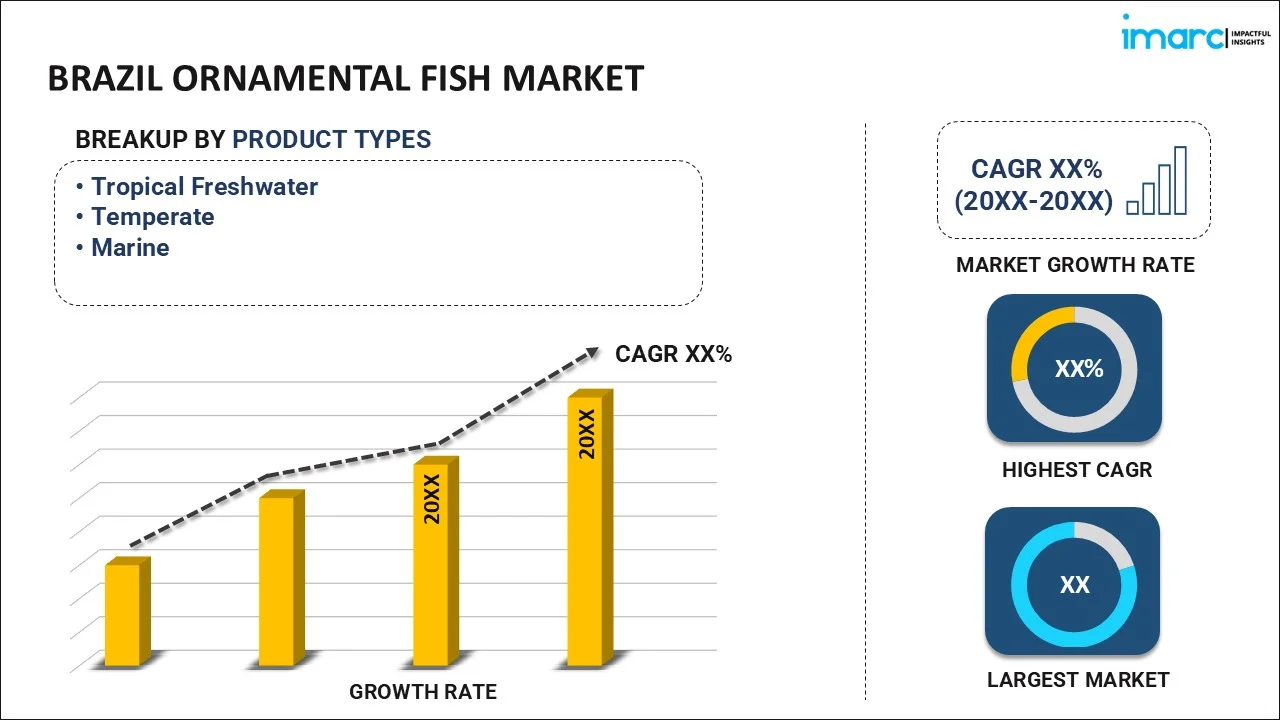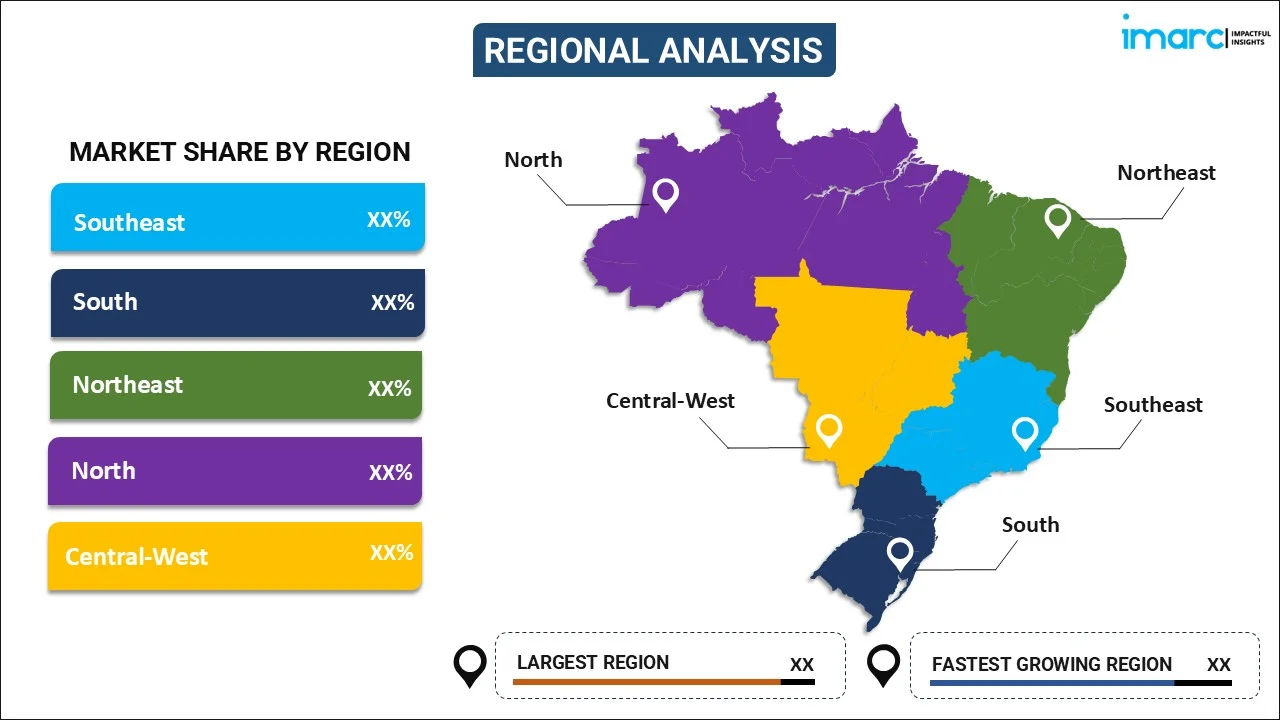
Brazil Ornamental Fish Market Size, Share, Trends and Forecast by Product, Application, and Region, 2026-2034
Brazil Ornamental Fish Market Overview:
The Brazil ornamental fish market size reached USD 158.0 Million in 2025. Looking forward, IMARC Group expects the market to reach USD 290.2 Million by 2034, exhibiting a growth rate (CAGR) of 6.99% during 2026-2034. The market is primarily driven by the increased demand for exotic species, robust export activities, and supportive governmental regulations ensuring sustainable breeding practices to improve biodiversity and environmental conservation efforts.
|
Report Attribute
|
Key Statistics
|
|---|---|
|
Base Year
|
2025 |
|
Forecast Years
|
2026-2034
|
|
Historical Years
|
2020-2025
|
| Market Size in 2025 | USD 158.0 Million |
| Market Forecast in 2034 | USD 290.2 Million |
| Market Growth Rate (2026-2034) | 6.99% |
Brazil Ornamental Fish Market Trends:
Rising Live Ornamental Fish Export Demand
According to the World Integrated Trade Solution, in 2023, the leading countries exporting live ornamental fish to Brazil included the United States, which exported $146,800 worth of fish weighing 4,230 kilograms, Sri Lanka with exports valued at $69,750 and weighing 1,549 kilograms, Australia at $45,770, the Dominican Republic with exports totaling $35,320 and weighing 9,341 kilograms, and the Philippines at $27,400. This demand boosts local businesses and the economy, encouraging investment in the sector and increasing international trade ties. Moreover, the vitality of the ornamental fish market is also enhanced by innovations in aquaculture technologies and breeding techniques that improve the health and coloration of the fish, making them even more appealing to international buyers. Besides, Brazil’s strategic geographic and environmental positioning allows for the cultivation and export of unique ornamental fish that are often unavailable, solidifying its status as a key player in the ornamental fish market. This robust export demand promotes economic growth and underscores the appeal of Brazil’s aquatic wildlife. These factors, combined with active participation in international trade shows and exhibitions, amplify Brazil’s presence in the global ornamental fish trade, demonstrating the country's commitment to maintaining a leading position in this niche market. Furthermore, such advancements and initiatives fortify the existing demand and attract new segments of consumers seeking unique and sustainable aquatic pets.
Supportive Environmental and Conservation Initiatives
Brazil’s dedication to environmental sustainability is evident in its stringent fishing and breeding regulations aimed at protecting its native species. These efforts are designed to prevent over-exploitation and ensure the long-term viability of wildlife populations, particularly those of ornamental fish. As a result of these protective measures, licensed breeders have been able to increase their production levels annually. This increase is a direct outcome of responsible breeding practices and adherence to regulations that promote ecological balance and market growth. For instance, in February 2025, Brazilian Fish, in partnership with the U.S.-based Centre for Aquaculture Technologies, unveils genetically edited Nile tilapia, enabling progress of a 20-year breeding program in one year, enhancing disease resistance and feed efficiency. Additionally, the success of these initiatives has led to a more sustainable and regulated ornamental fish market, which benefits the environment and the economy. By fostering a controlled growth environment, Brazil conserves its natural resources and enhances its market potential, providing high-quality, sustainably sourced ornamental fish to national and international markets. This proactive approach has helped establish Brazil as a model of effective environmental stewardship within the lucrative ornamental fish industry.
Brazil Ornamental Fish Market Segmentation:
IMARC Group provides an analysis of the key trends in each segment of the market, along with forecasts at the region/country level for 2026-2034. Our report has categorized the market based on product and application.
Product Insights:

- Tropical Freshwater
- Temperate
- Marine
The report has provided a detailed breakup and analysis of the market based on the product. This includes tropical freshwater, temperate, and marine.
Application Insights:
- Household
- Commercial
A detailed breakup and analysis of the market based on the application have also been provided in the report. This includes household and commercial.
Regional Insights:

- Southeast
- South
- Northeast
- North
- Central-West
The report has also provided a comprehensive analysis of all the major regional markets, which include Southeast, South, Northeast, North, and Central-West.
Competitive Landscape:
The market research report has also provided a comprehensive analysis of the competitive landscape. Competitive analysis such as market structure, key player positioning, top winning strategies, competitive dashboard, and company evaluation quadrant has been covered in the report. Also, detailed profiles of all major companies have been provided.
Brazil Ornamental Fish Market News:
- In June 2024, the Brazilian government secured sanitary clearance from the Philippines to export ornamental fish, marking it as the third market opening approved by the Philippines in the last six months for tilapia fingerlings and animal recycling products. In 2023, the Philippines purchased over USD 907 Million worth of Brazilian agribusiness goods, with beef, poultry, and pork being the primary commodities, making up 66% of this total. These achievements stem from the joint efforts of the Ministry of Agriculture and Livestock (Mapa) and the Ministry of Foreign Affairs (MRE).
Brazil Ornamental Fish Market Report Coverage:
| Report Features | Details |
|---|---|
| Base Year of the Analysis | 2025 |
| Historical Period | 2020-2025 |
| Forecast Period | 2026-2034 |
| Units | Million USD |
| Scope of the Report |
Exploration of Historical Trends and Market Outlook, Industry Catalysts and Challenges, Segment-Wise Historical and Future Market Assessment:
|
| Products Covered | Tropical Freshwater, Temperate, Marine |
| Applications Covered | Household, Commercial |
| Regions Covered | Southeast, South, Northeast, North, Central-West |
| Customization Scope | 10% Free Customization |
| Post-Sale Analyst Support | 10-12 Weeks |
| Delivery Format | PDF and Excel through Email (We can also provide the editable version of the report in PPT/Word format on special request) |
Key Questions Answered in This Report:
- How has the Brazil ornamental fish market performed so far and how will it perform in the coming years?
- What is the breakup of the Brazil ornamental fish market on the basis of product?
- What is the breakup of the Brazil ornamental fish market on the basis of application?
- What is the breakup of the Brazil ornamental fish market on the basis of region?
- What are the various stages in the value chain of the Brazil ornamental fish market?
- What are the key driving factors and challenges in the Brazil ornamental fish?
- What is the structure of the Brazil ornamental fish market and who are the key players?
- What is the degree of competition in the Brazil ornamental fish market?
Key Benefits for Stakeholders:
- IMARC’s industry report offers a comprehensive quantitative analysis of various market segments, historical and current market trends, market forecasts, and dynamics of the Brazil ornamental fish market from 2020-2034.
- The research report provides the latest information on the market drivers, challenges, and opportunities in the Brazil ornamental fish market.
- Porter's five forces analysis assist stakeholders in assessing the impact of new entrants, competitive rivalry, supplier power, buyer power, and the threat of substitution. It helps stakeholders to analyze the level of competition within the Brazil ornamental fish industry and its attractiveness.
- Competitive landscape allows stakeholders to understand their competitive environment and provides an insight into the current positions of key players in the market.
Need more help?
- Speak to our experienced analysts for insights on the current market scenarios.
- Include additional segments and countries to customize the report as per your requirement.
- Gain an unparalleled competitive advantage in your domain by understanding how to utilize the report and positively impacting your operations and revenue.
- For further assistance, please connect with our analysts.
 Request Customization
Request Customization
 Speak to an Analyst
Speak to an Analyst
 Request Brochure
Request Brochure
 Inquire Before Buying
Inquire Before Buying




.webp)




.webp)












